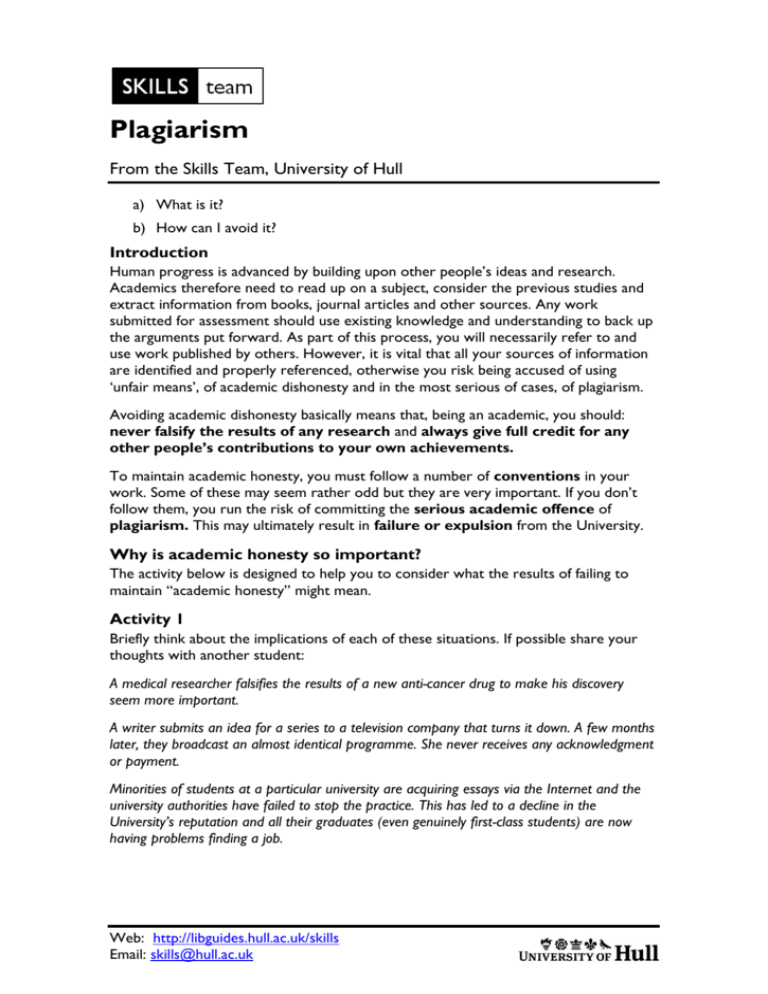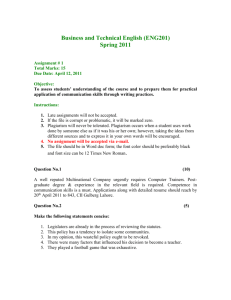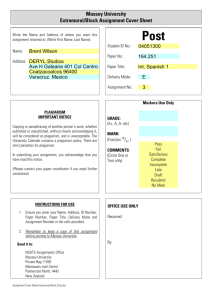Plagiarism - University of Hull
advertisement

Plagiarism From the Skills Team, University of Hull a) What is it? b) How can I avoid it? Introduction Human progress is advanced by building upon other people’s ideas and research. Academics therefore need to read up on a subject, consider the previous studies and extract information from books, journal articles and other sources. Any work submitted for assessment should use existing knowledge and understanding to back up the arguments put forward. As part of this process, you will necessarily refer to and use work published by others. However, it is vital that all your sources of information are identified and properly referenced, otherwise you risk being accused of using ‘unfair means’, of academic dishonesty and in the most serious of cases, of plagiarism. Avoiding academic dishonesty basically means that, being an academic, you should: never falsify the results of any research and always give full credit for any other people’s contributions to your own achievements. To maintain academic honesty, you must follow a number of conventions in your work. Some of these may seem rather odd but they are very important. If you don’t follow them, you run the risk of committing the serious academic offence of plagiarism. This may ultimately result in failure or expulsion from the University. Why is academic honesty so important? The activity below is designed to help you to consider what the results of failing to maintain “academic honesty” might mean. Activity 1 Briefly think about the implications of each of these situations. If possible share your thoughts with another student: A medical researcher falsifies the results of a new anti-cancer drug to make his discovery seem more important. A writer submits an idea for a series to a television company that turns it down. A few months later, they broadcast an almost identical programme. She never receives any acknowledgment or payment. Minorities of students at a particular university are acquiring essays via the Internet and the university authorities have failed to stop the practice. This has led to a decline in the University’s reputation and all their graduates (even genuinely first-class students) are now having problems finding a job. Web: http://libguides.hull.ac.uk/skills Email: skills@hull.ac.uk Clearly some of these situations have more immediately serious consequences than others, but they all impact on people’s lives and distort perceptions of the truth. In the long term, this affects us all. The above activity is adapted from one given at : http://staffcentral.brighton.ac.uk/xpedio/groups/Public/documents/staffcentral/doc00989 8.pdf So what exactly is plagiarism? Plagiarism is often described as “intellectual theft” or “intellectual fraud”. It is the term given to a specific type of academic dishonesty - making out someone else’s work, ideas or words are your own when they are not. Unfortunately, it can sometimes be unintentional. There is a particular danger of this if, in the past, you have been actively encouraged simply to compile material from outside sources to complete your work. In some cultures this may be the norm, even in higher education. At school level, many pupils are encouraged to cut and paste directly from web pages for project work; this would be regarded as plagiarism in higher education in the UK, unless the web pages were properly acknowledged and cited. Another potential danger is reading and making notes without recording the source of the notes at the time. Later you may have genuinely forgotten the source of the notes or even imagine the ideas were your own… One definition of plagiarism that is given in the University of Hull Regulations on the Use of Unfair Means, is: “What is plagiarism? It is work which purports to be a candidate’s own but which is taken without acknowledgement from the published or unpublished work of others. Such unattributed taking is plagiarism whether from articles, books, computer programs, data, essays, papers, reports, or any other material originated by another person, whether obtained from written, printed or electronic sources, including via the Internet, the World Wide Web (WWW) or any other computer-based or networked system. It is plagiarism whether the medium is literary (essays and reports), graphical (designs, diagrams, graphics), electronic (computer programs) or mathematical (proofs). Intention to commit the offence is not relevant to the finding of guilt, but may be relevant to the penalty imposed.” As you can see, the notion of “other’s work” in relation to plagiarism is very wide. It does not just mean printed works but also electronic sources, such as the WWW. This means it includes “articles, books, computer programs, data, essays, papers, reports, or any other material originated by another person”. (Perry, 2004) What about the copying of big chunks, using quotation marks and giving all of them accurate references and linking them with your own views? Well, in higher education, you are expected to think, form your own opinions and develop effective ways of expressing them. Such linking of long quotations would not be regarded as plagiarism. However, it would be considered bad practice and this would be reflected in a low mark. Quotations should be used sparingly. Plagiarism itself is a form of cheating and therefore unacceptable. It is important to remember that, as already mentioned, intention or a lack of intention make no difference as regards plagiarism. In the past, a number of students have found out, 2 to their cost, that not intending to plagiarise or being unaware that they are plagiarising are not considered excuses. You have been warned! Activity 2 Here are six ways to use sources. Example number one is plagiarism; example six is not. What about the rest? c) Copying a paragraph word by word from a source without any acknowledgement d) Copying a paragraph and making small changes - e.g. replacing a few verbs, replacing an adjective with a synonym, no quotation marks; acknowledgement in the bibliography e) Cutting and pasting a paragraph by using sentences of the original but omitting one or two and putting one or two in a different order, no quotation marks; with an in-text acknowledgement plus bibliography f) Composing a paragraph by taking short phrases from a number of sources and putting them together using words of your own to make a coherent whole with an in-text acknowledgement plus bibliography. g) Paraphrasing a paragraph by rewriting with substantial changes in language and organisation; the new version will also have changes in the amount of detail used and the examples cited; citation in the text & bibliography h) Quoting a paragraph by placing it in block format with the source cited in text & bibliography Comments on this activity are given at the end of this leaflet. (The examples above are based on an exercise by Swales and Feak (1993)) Are there levels of Plagiarism? “The significance of an act of plagiarism is greater the further a student is advanced in his or her career at University. At the Certificate stage (Year 1) students may be said to be still learning the ethos of University work, and many are still developing that punctilious care which should distinguish academic work. By the Diploma stage (Year 2), however, students should be well aware of the important distinction between highly derivative work and plagiarism. It follows that an offence of plagiarism is most reprehensible at the Final stage (Year 3)”. (Perry, 2004) Avoiding Plagiarism How then can you be sure that you are not guilty of plagiarism? In a word: REFERENCE. That means you need to make sure that all your work has proper referencing, following whatever conventions your department requires. These conventions vary from department to department and it is important to find out what they are. Such information will usually be found in DEPARTMENTAL HANDBOOKS. Check yours if you have any doubts! 3 The Skills team has Skills Guides on referencing and plagiarism on the web: http://libguides.hull.ac.uk/skills Both plagiarism and referencing are dealt with in the following site in a very easy to read way: http://www.bath.ac.uk/library/infoskills/referencing-plagiarism/ There is also plenty of advice available elsewhere on the internet. The extract below, by Van Bramer, gives sound advice on avoiding plagiarism: “Only use someone else’s writing when you want to quote precisely what they wrote. If this is not your goal, USE YOUR OWN WORDS. a) This avoids any ambiguity about who wrote it. After all, you do not want someone to accuse you of plagiarism. b) You need to learn how to write in your own style. You may be influenced by authors that you find clear and easy to understand, but your writing needs to be YOUR writing. Mimicking someone else is not a productive exercise. You just learn to cut and paste. c) An instructor who is reading or grading your work is interested in YOUR understanding of an idea. I am not interested in your ability to copy explanations from the textbook. I know that the author of the book understands it, which is why I picked the textbook. I need to know if YOU understand it. d) Understanding and learning is more than just replaying something you have heard. Writing is a valuable exercise that tests your ability to explain a topic. I often think I understand something, until I try to write it out. This is an important part of learning.” Van Bramer, S.E. (1995) If you want to use an author’s ideas and express them in your own words, it can be helpful to: study the ideas shut the book and only then, write your own version of what you have read Then remember to acknowledge that the ideas were not your own. A final warning A new service that can scan 4.5 billion web pages is now online allowing lecturers to check the originality of work submitted by students. ...and a few words of reassurance Some students become over anxious about committing plagiarism. Providing that you follow the guidelines, you will avoid doing so. “If in any doubt, ASK!” (Pyper,H. n.d.) 4 Comments on activity 2 1. plagiarism 2. plagiarism (the original author’s own words have been used and this has not been shown by the use of quotation marks.) 3. plagiarism ( as for 2.) 4. plagiarism (as for 2 - phrases are made up of words used by the author(s) and this has not been indicated.) 5. not plagiarism (the writer has used his or her own words but acknowledged that the ideas are taken from someone else.) 6. not plagiarism (the quotation is clearly indicated and the source given.) References Perry, I. (2004) Academic & Professional Skills - Plagiarism and Referencing, Powerpoint Presentation, University of Hull, Business School. Neville C. (2010) Complete guide to referencing and avoiding plagiarism, [online] Books.google.com Swales, J.M. and Feak, C.B. (1993) Academic Writing for Graduate Students University of Michigan University of Brighton, (n.d.) [online] http://staffcentral.brighton.ac.uk/xpedio/groups/Public/documents/staffcentral/doc 009898.pdf All my own work?: workshop slides for use in conjunction with the Plagiarism Awareness Pack 2009-10 [accessed 09/07/10]. University of Hull, (2008) Regulations on the Use of Unfair Means [online] http://www2.hull.ac.uk/student/studenthandbook/academic/unfairmeans.aspx [Accessed 21/06/11]. Van Bramer, S.E. (1995), What is plagiarism? [online] Chester PA, USA: Widener University. http://science.widener.edu/svb/essay/plagiar.html [accessed 24/11/05] 5






